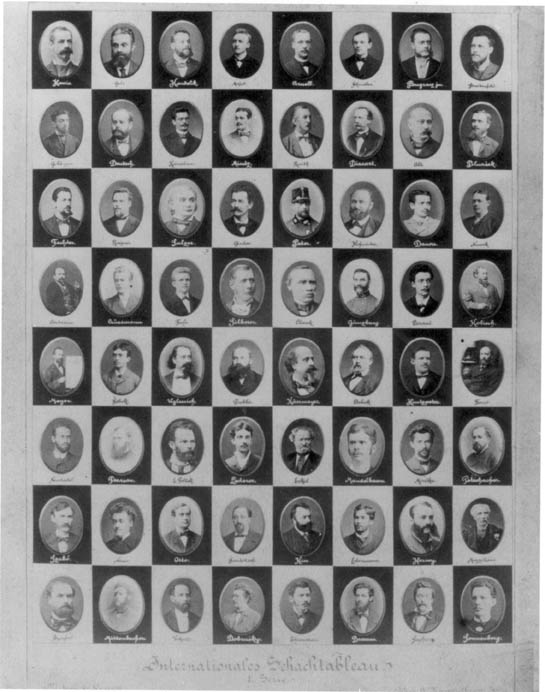
When contacting us by e-mail, correspondents are asked to include their name and full postal address and, when providing information, to quote exact book and magazine sources. The word ‘chess’ needs to appear in the subject-line or in the message itself.
| First column | << previous | Archives [3] | next >> | Current column |
Regarding Harry Golombek’s book on the 1948 world championship match-tournament in The Hague and Moscow, the following untrue statement is quoted on page 42 of the December 2004 Chess Life:
‘The author of this book was on the spot throughout and at the very epicenter of all the action.’
In reality, Golombek was not present in Moscow at all, as he explained in his introduction to the 1982 BCM edition of the book:
‘The time came when the event moved off to Moscow. I endeavoured to follow the big group of Dutch and Russian chess masters and officials but was unable to gain a visa. [H.G. then gave further details.]
So I had to be content with studying the games of the Russian section of the tournament in the Soviet bulletins. Fortunately, these were very well annotated and there were also quite elaborate descriptions of the playing hall and the various circumstances that attend a great tournament.’

Another composite photograph, further to C.N. 3478. A larger version can be viewed by clicking here.
C.N.s 1744 and 1814 (see pages 135-136 of Chess Explorations) discussed Alfred Kreymborg’s article ‘Chess Reclaims a Devotee’, which was reproduced on pages 6-18 of The Fireside Book of Chess by I. Chernev and F. Reinfeld (New York, 1949). It may be recalled that Kreymborg asserted that, after a painful loss to Chajes (in 1911), ‘I resolved to have done with chess tournaments, chess clubs and chess forever after’.
The article was undated, although the opening sentence began, ‘Recently, after an absence of nearly 20 years from the chess world, I returned to the game of my first love...’ We would now add that the complete text had already been included in an earlier anthology, The Art of Chess Playing by E.V. Mitchell (New York, 1936); the acknowledgements page stated that it had originally appeared in The American Mercury (date unspecified).
John Hilbert (Amherst, NY, USA) points out that two games involving Kreymborg (a win against E.B. Adams and a loss to A.C. Cass) were published in Chess Review in 1938 (April, page 96 and June, page 133 respectively). Below is the former, together with the American magazine’s introduction.
‘One of the most interesting games of the match was won by the noted poet Alfred Kreymborg. In answer to a request by Horowitz for the game, he wrote:
“I haven’t played hard chess for 23 years. ... I’m quite certain that after White’s 21st move, a sound, though crazy-looking move, Black must lose. ... By the way, I’ve written a play called Queen’s Gambit Declined, which is dedicated to the Club. It was published by Samuel French. Maybe we’ll act it out some day. It needs only four actors, but they have to be better actors than chessplayers.”’
Alfred F. Kreymborg – Edward Bradford Adams
Manhattan Chess Club v Marshall Chess Club, New York, 12 March
1938
Nimzowitsch Defence
1 e4 Nc6 2 d4 e5 3 d5 Nce7 4 c4 d6 5 Nc3 f5 6 Bd3 g6 7 h4 h5 8 Bg5 Bh6 9 Qd2 f4 10 Nf3 Bg4 11 Bxh6 Bxf3 12 gxf3 Nxh6 13 O-O-O O-O
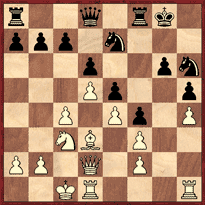
14 Bf1 Rf6 15 Bh3 c5 16 Be6+ Kh7 17 Rhg1 a6 18 Qd3 Qe8 19 a4 Nc6 20 dxc6 Rxe6 21 c7 Rc8 22 Nd5 Ng8 23 Rg5 Ne7 24 Rdg1 Nc6 25 b3 Qf7 26 Kb2 Nd4 27 Ka2 Rf8 28 Ka3 Qd7 29 a5 Nc6
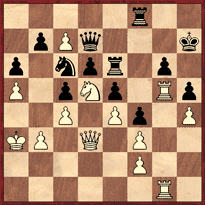
30 Qf1 Nxa5 31 Qh3 Re7 32 Qg2 Ref7 33 Rxg6 (33 Rxh5+ would have been the natural finish.) 33...Qe8 34 Rh6+ Resigns.
Readers wishing to examine databases for further play by Kreymborg should note that, for some reason, they often spell his name ‘Kreymbourg’.
Beginners’ books continue to offer less-than-perfect definitions of double check, a recent example coming from page 248 of The Chess Player’s Bible by James Eade (Hauppauge, 2004):
‘Double check A discovered check when the moving piece also delivers a check.’
To the position given in C.N. 3138 may be added the following, submitted by Jim Walsh to CHESS, 15 April 1960 (page 236):

‘Black’s last was ...e5. White replies dxe6 delivering double check without the pawn itself checking.’
On the same page of the magazine the task of constructing a double-check position without any move by a checking piece was described by Wolfgang Heidenfeld as follows: ‘This is easy by using the e.p. capture and has been shown frequently.’ Nonetheless, as noted in C.N. 3138, Heidenfeld himself wrote on page 88 of The Encyclopedia of Chess by H. Golombek (London, 1977) that double check was ‘A discovered check in which both pieces check the hostile king …’.
From page 17 of How To Get More Out Of Chess by F. Reinfeld (New York, 1957):
‘The enjoyment of chess endings is an acquired taste. The more you work with them, the more you will enjoy them. I am willing to claim that, page for page, a book of such endings offers perhaps the most rewarding pleasure that we can get from any aspect of chess.’
On pages 35-36 he presented a well-known study by Selesniev (from 64, 1935):
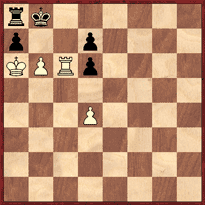
White to play and win.
The solution was given as 1 Rc8+ Kxc8 2 b7+ Kb8 3 d5, and Reinfeld now blundered by commenting, ‘He must play 3...Kc7, allowing 4 bxa8(Q) and wins’. Readers will require no prompting from us as to the fourth move for White actually intended by Selesniev.
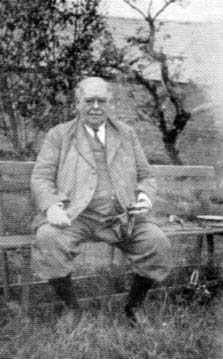
What did he invent?
‘A really brilliant victory, especially when it is considered that Capablanca was playing 32 other players at the same time.’
So wrote D. Hooper and D. Brandreth on pages 152-153 of The Unknown Capablanca (London, 1975) when giving the following game, taken from Chess News, 1916, page 44:
José Raúl Capablanca – N.N.
New York, 11 January 1916
Queen’s Gambit Declined
1 d4 d5 2 Nf3 Nf6 3 c4 e6 4 Nc3 Bd6 5 Bg5 c6 6 e3 O-O 7 Rc1 dxc4 8 Bxc4 Nbd7 9 Bd3 Be7 10 O-O b6 11 Qc2 Bb7 12 Ne5 g6 13 Bh6 Re8 14 Rfd1 Nxe5 15 dxe5 Nd5 16 Nxd5 exd5 17 e6 f5 18 Bxf5 gxf5 19 Qxf5 Bf6 20 e4 Qe7 21 exd5 cxd5
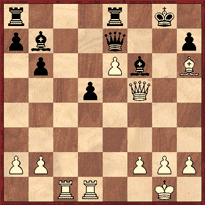
22 Rc7 Qxc7 23 Qxf6 Qe7 24 Qe5 Rf8 25 Rd3 Qf6 26 Rg3+ Kh8 27 Bg7+ Resigns.
This game was chosen to represent the year 1916 in Jonathan Hinton’s 1999 book A Gnat May Drink and was the only one in the collection to feature an anonymous player. Can a reader examine the New York press of the time in an attempt to identify Black?
Unconvincing chess anecdotes abound, but when they include names our curiosity may be aroused. An example comes from page 66 of Bitte, Bleiben Sie Seriös! (Bad Nauheim, 1958), i.e. a claim that in Hastings a young player named Parker played a series of brilliant combinations against an unidentified opponent and won a game which had been widely considered lost. He was then allegedly told by Alekhine, ‘If you had played correctly, you would never have won this game’.
For the record the German version is given below:
‘Beim traditionellen Schachturnier in dem britischen Badeort Hastings gewann der junge Engländer Parker durch eine Reihe brillanter Kombinationen und gewagter Figurenopfer eine Partie, die man allgemein bereits verloren gehalten hatte. Nach seinem Sieg wurde Parker von allen Seiten beglückwünscht. Lediglich Weltmeister Aljechin runzelte missbilligend die Stirn. “Eines muss ich Ihnen sagen, mein junger Freund”, meinte er in vorwurfsvollem Ton zu Parker, “wenn Sie richtig gespielt hätten, dann hätten Sie diese Partie niemals gewonnen”.’
We have been unable to match this account with any of Alekhine’s visits to Hastings.
On page 478 of the December 1928 BCM G.H. Diggle reported that a player named J. Parker had been a member of the Grimsby Chess Club for over 53 years, and added:
‘Mr Parker has another remarkable record. He has never lost a game against a master in a simultaneous display. He has drawn with Bird and Pollock and has beaten Skipworth, Zukertort, Blackburne (twice), Yates and Capablanca. The two games he played against Bird and Zukertort are to be found in the BCM for 1885.’
We pick the former, from an exhibition in which Bird scored +13 –2 =2:
Henry Edward Bird – J. Parker
Leeds, 8 January 1885
Two Knights’ Defence
1 e4 e5 2 Nf3 Nc6 3 Bc4 Nf6 4 Ng5 d5 5 exd5 Na5 6 Bb5+ c6 7 dxc6 bxc6 8 Be2 h6 9 Nf3 e4 10 Ne5 Bd6 11 d4 Qc7 12 Bf4 O-O 13 Nd2 Nd5 14 Bg3 e3 15 Ndf3 exf2+ 16 Bxf2 Nf4 17 O-O Re8 18 Bd3 c5 19 c3 Bb7 20 Bb5 Re7 21 Bg3 Nd5 22 Qa4 a6 23 Bd3 Nc6 24 Rae1 cxd4 25 cxd4 Nxd4 26 Nxd4 Bxe5 27 Nf5 Re6 28 Bxe5 Rxe5 29 Rxe5 Qxe5 30 Qd7 Qc7 31 Ne7+ Kf8 32 Ng6+ Kg8 33 Qxc7 Nxc7 34 Bc4 Kh7 35 Bxf7 Bd5 36 Ne5 Bxf7 37 Rxf7 Nd5 38 Rb7 Rc8 39 h4 Rc2 40 g4 Nf4 41 Rb3 Re2 42 Rf3 Re4 43 Kf1 Nd5 44 Nd7 Rxg4 45 Ra3 Rxh4 46 Rxa6 ‘and after a few more moves the game was drawn’.
Source: BCM, August-September 1885, pages 295-297.
Parker’s win over Capablanca was in Sheffield on 8 October 1919. The concluding moves were given on page 107 of the 2/1999 Quarterly for Chess History.
Footage of old events (such as living chess displays featuring Capablanca and Alekhine, against Sir George Thomas and Bogoljubow respectively) can be viewed at the following site: http://www.britishpathe.com/
Browsing through Testament d’Alekhine by A. Baratz (Paris, 1972), we have noted references to Alexandre, Andersen, Beck, Botvinik, Botvinick, Botivinik, Chmit, Cler, Flor, Golombec, Greenfield, Murphy, Nimtzovitch, Rechewski, Rechevsky, Reshevski, Saemish, Snoskoborovski, Tall, Tarasch, Tarrach, Tarrash, Taylor, Zemich and even, on page 169, Baratk.
In 1982 C.N. 164 reported that we had been in correspondence with the publishers of The Guinness Book of Records. The result was that a number of the book’s inaccuracies were corrected and, in particular, subsequent editions added an entry on Capablanca’s small number of losses in his adult career and his unbeaten record between 10 February 1916 and 21 March 1924.
How long Capablanca’s feat remained in the Guinness book we do not know, but certainly it was still there many years later. Before us lies the US paperback 1988 Guinness Book of World Records, which had a chess section some 70 lines long (pages 564-565). This also featured the most simultaneous chess games, the most consecutive games, the most blindfold games, the longest game, the slowest move, the earliest loss on time, the longest tenure of the world championship, the highest-ranked player, the most active world champion, the youngest world champion, various women’s records, and the longest recorded session of playing chess.
The other day we had the misfortune to come across the latest edition, Guinness World Records 2005 (London, 2004), and found that the chess content has been not so much dumbed down as drummed out. There is no chess section at all, the only references to the game being four brief entries under various headings.
In the ‘Toys’ section on page 108 (immediately following
information on the ‘Longest Hot Wheels track’) comes this: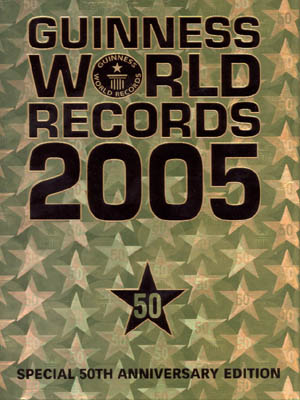
‘Largest chess piece
Mats Allanson (Sweden) has made a scaled-up king measuring 4m (13ft) high and 1.4m (4ft 6in) in diameter at the base.’
The next page (still the ‘Toys’ section) has:
‘Earliest chess pieces
‘Chessmen found at Nashipur, modern-day Bangladesh, have been dated to c. AD 900 and are the oldest known in existence.’
Then on page 110 (‘Games & pastimes’), just after the reader has been apprised of the ‘Farthest wink shot in tiddlywinks’, the following is offered:
‘Most opponents in consecutive chess games
Between 27 and 28 February 2001, Anna-Maria Botsari (Greece) played 1,102 consecutive [sic – simultaneous was meant] games of chess against different opponents, with just seven draws and the rest wins, at Kalavryta, Greece.’
That is the only reference to chess in the ‘Games & pastimes’ section.
Page 153 marks the final occasion when the existence of chess is acknowledged:
‘Largest networked chess computer
On 30 January 2004 Grand Master Peter Heine Nielsen (Denmark) played a game of chess against ChessBrain, the world’s largest networked chess computer. ChessBrain consisted of 2,070 computers located in 56 countries, which simultaneously combined their processing power.The match, which took place in Copenhagen, Denmark, ended in a draw after 34 moves.’
And that is it. Not one world-class chess master is mentioned by name. There is no indication that any championship title has ever existed. Indeed, the total space devoted to chess in the entire book is less than that accorded on page 113 to an exploit by Kathryn Ratcliffe (UK), who, on 25 October 2003 and with a tally of 138, broke her own record ‘for the most Smarties eaten in three minutes using chopsticks’.
1 Rxg7+ Kh8 2 Rxh7+ Kg8 3 Rbg7 mate.
What is known about the origins of this term, and Janowsky’s alleged connection with it?
The answer is Kriegspiel, the inventor of which was Michael Henry Temple (1862-1928).
One of the few top-level chess masters to have taken up Kriegspiel was Alekhine, as is shown by two quotes from the 1926 BCM (March, page 124 and July, page 314 respectively):
‘Monsieur Alekhine (now a naturalized Frenchman and an official representative of French chess) remained in this country for a short time after his success at Hastings. On 9 January he spent the afternoon at the Imperial Chess Club playing Kriegspiel and beat every one of his opponents.’
‘The Kriegspiel Tournament [in Scarborough] was won by Alekhine, who is an adept at this lighter branch of the game, and Mrs Stevenson gained a popular success in coming second.’
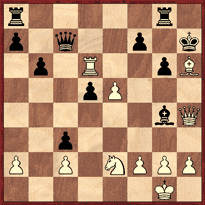
On page 248 of the September 1953 BCM D.J. Morgan wrote:
‘You will frequently find the same error repeated in book after book. Thus, in this position, du Mont’s The Basis of Combination in Chess, Korn’s The Brilliant Touch and Richter’s Kombinationen all give a polished finish with 1 Bf8+ Bh5 2 Qxh5+ gxh5 3 Rh6 mate. The score of the game (see, for instance, The Year-Book of Chess, 1908) shows that Důras actually won more prosaically with 1 Nf4 Rh8 2 Nxd5 Qxd6 3 exd6 Bh5 4 Be3 Rad8 5 Qg5 Resigns.’
It might have been added that the Carlsbad, 1907 tournament book (page 107) reported that the quick mate had been indicated by Tietz.
Over half a century after D.J. Morgan wrote his remarks about errors being repeated in chess books the queen sacrifice continues to be presented as if it occurred in actual play. Such is specifically stated in, for example, Checkmate! (subtitle: My first chess book) by G. Kasparov (London, 2004). See pages 58 and 86.
Below, from our collection, is a letter written by J. du Mont on 5 February 1942.
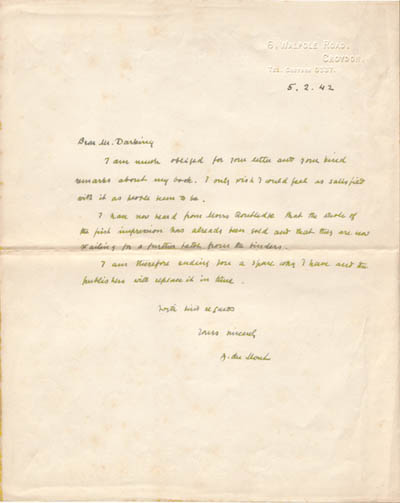
Click here for a larger version.
The book referred to is the first edition of 200 Miniature Games of Chess (London, 1941), our copy of which is also inscribed by du Mont.
His obituary in the BCM (May 1956, pages 119-120) was by D.J. Morgan and included the following passage, on which we have no further information:
‘He came to England as a young man and brought with him a considerable talent for chess. ... He quickly mastered our language and showed this during the First World War by writing a manual on the Lewis gun.’
C.N. 3267 reported that on pages 21-22 of his book Winke für die Schachstrategie (Berlin and Leipzig, 1927) Tartakower gave a short game won by Emanuel Rubinstein and that he commented:
‘A player with the forename of the great Lasker and the surname of the great Akiba is certainly predestined to brilliant achievements.’
We asked for information about Emanuel Rubinstein, and now Tomasz Lissowski (Warsaw) provides a considerable amount. Below is an abridged version.
‘An article entitled “Chess in Poland” on pages 168-172 of the June 1926 Wiener Schachzeitung began by expressing gratitude to “our collaborator Emanuel Rubinstein from Cracow”. Pages 255-256 of the August-September 1926 issue had a feature with the same title which gave the results of a tournament played in Cracow. M. Chwojnik, later known as Dr Oren, won easily, with eight points out of ten, while Rubinstein came fourth with five and a half.
I have found a photograph of Emanuel Rubinstein, in a large group of Cracowian and Silesian chessplayers:
He was among the participants in the First Polish Team Championship, played in Upper Silesia (Southern Poland), and the following game was played in round three:
S. Kohn – Emanuel Rubinstein
Królewska Huta, 6 April 1929
Queen’s Gambit Declined1 Nf3 Nf6 2 d4 d5 3 c4 e6 4 Nc3 Nbd7 5 Bf4 Bb4 6 Qb3 Bxc3+ 7 bxc3 O-O 8 e3 Nh5 9 cxd5 Nxf4 10 exf4 Nb6 11 Be2 exd5 12 O-O Qf6 13 g3 Bg4 14 Rfe1 Rfe8 15 Ne5 Bxe2 16 Rxe2 Re6 17 Qc2 g6 18 Ng4 Qe7 19 Rae1 Rxe2 20 Rxe2 Qd6 21 f5 Nc4 22 Qc1 h5 23 Ne5 Kg7 24 Nxf7 Kxf7 25 Re6 Qxe6 26 fxe6+ Kxe6 27 Qb1 Resigns.
Source: Swiat Szachowy, 4-5/1929, pages 58-59.
Królewska Huta is now part of Chorzów city. Rubinstein scored +3 –1 =1, and his team (Cracow) took third prize, after Warsaw and Lodz.
In subsequent years the chess press paid less attention to him. From 1918 to 1939 Cracow was outside the mainstream of Polish chess life, which was concentrated along the Lvov–Warsaw–Lodz axis.
The game below was given in Ilustrowany Kurier Codzienny, 8 August 1932:
Emanuel Rubinstein – Pawel Mróz
Cracow v Silesia match, Cracow, 8 June 1932
Sicilian Defence1 Nf3 Nf6 2 c4 c5 3 Nc3 d6 4 d4 cxd4 5 Nxd4 Nc6 6 e4 g6 7 Be2 Bg7 8 Be3 O-O 9 O-O a6 10 f3 Qc7 11 Qd2 Nd7 12 Nd5 Qd8 13 Rad1 Rb8 14 f4 Nc5 15 Nc3 Nxd4 16 Bxd4 Bxd4+ 17 Qxd4 f6 18 e5 Ne6 19 Qa7 fxe5 20 fxe5 Bd7 21 exd6 exd6 22 Rxd6 Qe7 23 Rdd1 Bc6 24 Nd5 Qh4 25 Qe3 Rbe8 26 g3 Qg5 27 Rxf8+ Kxf8 28 Rf1+ Kg7 29 Qc3+ Kh6 30 h4 Qd8 31 Qe3+ Kg7 32 Qe5+ Kh6 33 Rf7 Bxd5 34 cxd5 Qb6+ 35 Kf1 Qd4 36 Qxd4 Nxd4 37 Bg4 Rd8 38 Rd7 Rf8+ 39 Kg2 b5 40 d6 Rf6 41 Kh3 a5 42 Bd1 Nf5 43 g4 Resigns.
In 1937 Rubinstein again participated in the traditional Cracow v Silesia team match, defeating the little-known player Maruszczyk at board 15. The following year he stepped up his chess activity:
Emanuel Rubinstein – Bass
Cracow Championship, 1938
Queen’s Gambit Declined1 Nf3 Nf6 2 d4 d5 3 c4 e6 4 Nc3 c5 5 cxd5 Nxd5 6 e4 Nxc3 7 bxc3 cxd4 8 cxd4 Bb4+ 9 Bd2 Qa5 10 Bd3 Bd7 11 O-O Bxd2 12 Nxd2 Nc6 13 Nc4 Qc7 14 d5 Ne5 15 dxe6 Bxe6 16 Nxe5 Qxe5 17 Rb1 O-O 18 Rxb7 Rfd8 19 Qb1 g6 20 a4 Rd4 21 f4 Qc5 22 Rb5 Qd6
23 f5 Bd7 24 e5 Qc7 25 fxg6 hxg6 26 Bxg6 Rf8 27 e6 Bxb5 28 Bxf7+ Kh8 29 Qg6 Resigns.
Source: Nowiny Szachowe, 5/1938, pages 8-9.
Edward Arłamowski – Emanuel Rubinstein
Cracow Championship, 9 April 1938
Queen’s Indian Defence1 d4 Sf6 2 Nf3 e6 3 e3 b6 4 Bd3 Bb7 5 Nbd2 c5 6 O-O Nc6 7 c3 Be7 8 Qe2 O-O 9 e4 cxd4 10 cxd4 d6 11 a3 Rc8 12 b4 Rc7 13 Bb2 Qa8 14 Rac1 Rfc8 15 g3 a6 16 Rcd1 g6 17 Nc4 Qa7 18 e5 Ne8 19 Ba1 b5 20 Nxd6 Nxd6 21 exd6 Bxd6 22 Qb2 f6 23 Rfe1 Nd8 24 d5 e5
25 Nxe5 fxe5 26 Rxe5 Rc3 27 Re8+ Kf7 28 Rxd8 Be5 29 Rxc8 Bxc8 30 Qe2 Bd4 31 Bxc3 Bxc3 32 Qf3+ Bf6 33 Rc1 Bd7 34 Rc5 Qb7 35 Qf4 Qa8 36 Qd6 Qe8 37 Rc7 Resigns.
Source: Szachista, 9/1938, pages 129-130.
In that championship Rubinstein finished equal 2-4 with Arłamowski and Październy, behind Henryk Scheier.
At the beginning of September 1939 Cracow was seized by the Wehrmacht. Thousands of Polish citizens, among them many of Jewish background, sought salvation in the eastern part of Poland, which was occupied by the Soviet Army. In 1940 Rubinstein was reported (by Arłamowski in the January 1946 issue of Szachista Polski) to be in Lvov, which was then part of the Ukrainian Soviet Republic. Life in the new “homeland” was no paradise, but the situation became even worse when Hitler invaded the Soviet Union in June 1941.Did Emanuel Rubinstein share the fate of Dawid Przepiórka, Karol Piltz, Henryk Friedman, Edward Gerstenfeld, Marian Wójcik, Achilles Frydman and many other Polish chessplayers – victims of the War or the Holocaust? The March 1947 issue of Szachista Polski published the results of that year’s Cracow Championship. There was a Rubinstein who finished tenth, but unfortunately the players’ forenames were not given.
It is not certain that Rubinstein survived the War. Professor Andrzej Kwilecki of Poznan, who was active in the Cracow Chess Club at that time, has been able to provide me with only a few details. He told me that the Rubinstein in Cracow in 1947 was not particularly strong, despite defeating the tournament winner, Aleksander Ameisen. The latter accepted his ill-fortune with a philosophical smile and voiced one of his famous sayings:
“A master in a tournament has, as a rule, one weaker day, and the weakest player has one good day. When these two days happen to be in the same round, and Fortune pairs the players with each other, there is a sensation.”’
C.N. 3481 quoted some assertions by Walter Korn about Capablanca’s origins. Another passage on the Cuban’s ancestry was on pages 48-49 of volume one of Capablanca, Leyenda y Realidad by Miguel A. Sánchez (Havana, 1978). Below is the translation given on page 134 of our book on Capablanca:
‘The son of a major in the Spanish army, a native of Navarra, José María Capablanca was a peaceable man urged into the army at the inviolable wish of his father. He was born in Bayamo on 21 January 1862 and 22 years later, on 19 May 1884, he wed the matancera María Graupera Marín, the great-granddaughter of Tranquilino Sandalio de Noda, the learned naturalist. The marriage gave 11 children, but in early 1892 only three of them were taking their first steps: Salvador (born in 1885), José Raúl (19 November 1888) and Alicia (1890).’
We have now been in correspondence with Manuel González Dávila (Madrid) and Fernando Capablanca (Miami, FL, USA). The latter, the son of Aquiles Capablanca, is a nephew of Capa. We begin by quoting our Spanish correspondent’s contribution:
‘Capablanca is an extremely rare surname in Spain. Spaniards have two surnames, and today only 29 people living in Spain have Capablanca as their first surname (i.e. that of their father), and only 24 have it as their second surname (i.e. that of their mother). Of the 29, 14 are of Spanish nationality. All those in the group of 24 are Spanish. These are official figures, obtained from the INE (Instituto Nacional de Estadística, the Spanish Central Statistical Office).
Fernando Capablanca has carried out a great deal of research and even checked many baptism records (at the main church in Valdepeñas), supplementing them with information gathered from the Archivo General Militar (the Central Register Office of the Spanish Army) in Segovia. It can be reported that Capa’s grandfather, Tadeo Capablanca Broca, was born in Valdepeñas (province of Ciudad Real, Spain). He was married to Bernarda Fernández Brieva and he died in 1885. In the Spanish army he was a “Comandante”, i.e. a commanding officer or commander, usually translated into English as major.
Fernando Capablanca has also told me, with regard to Capa’s father:
“He was actually born in Cuba at the time when Cuba was a province of Spain (and it could therefore be said that he was ‘Spanish’ and not Cuban). In fact, Capa was, technically, also born in Cuba, Spain because he was born in 1888, when Cuba was a Provincia Real – never a Colony. Ironically, I found a letter from my grandfather asking the army HQ to transfer him back to Spain in 1896, a couple of years before the Spanish-American War. The request was refused, and he therefore had to stay in Cuba, where my father and the later siblings were born under a Republic. It seems that half of my uncles and aunts were born in Cuba, Spain and the other half in Cuba, Cuba.”
As regards C.N. 3481, there is obviously almost no relationship between Korn’s passage and Morán’s. Morán’s remark that all Spaniards have a drop of Jewish blood is a very general comment often used in Spain, referring not only to Jews but also Arabs, for instance. It is not a scientific fact (there is no statistical answer to the question, “How many Spaniards have a Jewish ancestor?”).
However, in the light of the research by Fernando Capablanca, I do not think that this is the case if we refer to the surname Capablanca. I have checked this possibility with a relative of mine (my uncle José Antonio Dávila, who is an expert in genealogy, lineage and nobility). It seems to him wholly unreasonable to suppose that the surname Capablanca would have been chosen by a Jew remaining in Spain (based upon the many historical studies that have been made on that subject).
With respect to Korn’s statement about “Capablanca’s family having left Spain for Cuba – shortly after its discovery by Columbus in 1492 – due to the expulsion of Sephardic Jews from Spain, and the latest persecution there of baptized Jewish “Marranos”, I know of no facts to corroborate that.’
Fernando Aquiles Capablanca (Miami, FL, USA) has informed us:
‘I did some research myself at the military archives in Segovia, Rome and Malta. As far as I have been able to determine, the earliest record of any Capablanca arriving in Cuba was my great-grandfather (José Raúl’s grandfather) circa 1830. It also appears that the name was originally Cappabianca from the town of Aversa, near Naples, Italy and transferred to Spain (under the Bourbon Empire) in the early sixteenth century. In fact, I received a document from Malta which may suggest that some of the early members of the family were Crusaders and members of the Order of Malta, as appears to be the case with one Dessio Cappabianca. I often wonder if the name itself refers to the Crusaders’ custom of using a white cape (Cappa Bianca) with the red cross emblazoned on the cape. My grandmother, María Graupera, was Catalonian. I have never come across any papers that would lend support to the theory that my ancestors arrived in Cuba with, or shortly after, Columbus, although it appears now that Columbus himself was either a member of, or was sponsored by, the Order of Malta (not to be confused with the Templars), as indicated by the red cross on the sails of the caravels in which he sailed. I have not seen anything either that would indicate a Jewish connection, and it seems to be unsupported speculation to say otherwise. By the way, I also found baptismal records of many of my ancestors at the main church in Valdepeñas, Spain (La Mancha region, south of Madrid).’
From William D. Rubinstein (Aberystwyth, Wales):
‘Yad Vashem, the Holocaust Museum and Memorial in Israel, has just released its database of the names of three million Jews known to have perished in the Holocaust. It can be consulted at this address: www.yadvashem.org
No-one named Emanuel Rubinstein, or any obvious spelling variation, is listed. This does not mean he survived the War, as the Yad Vashem list is incomplete; the names have been provided voluntarily by relatives and others since the early 1950s. However, one can say that there is no evidence that he did not survive the War.’
C.N. 2162 gave, from pages 238-239 of the June 1858 Deutsche Schachzeitung, a capped-knight game between Max Lange and ‘Jenny v. S.’; see pages 114-115 of Kings, Commoners and Knaves. Now we are informed by Richard Forster (Winterthur, Switzerland) that the game was presented by Lange on pages 154-155 of his book Sammlung Neuer Schachpartien (Leipzig, 1857) and that Black was identified as ‘Fräulein Jenny von Schierstedt’.
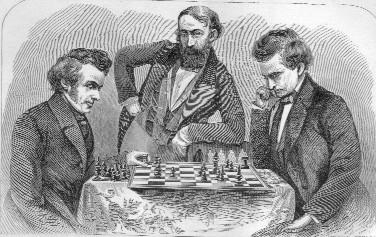
This picture was published in Brevity and Brilliancy in Chess by M.J. Hazeltine (New York, 1866). From the author’s Introduction (pages x-xi):
‘The engraving forming our frontispiece has a genuine historical interest in the records of American chess. It illustrates the first really well-appointed passage at arms in Caissa’s lists, by an American challenger against a champion of name from the old world. And the likenesses, thanks to the painstaking skill of an accomplished artist, are admirably preserved, pleasing reminders of so memorable an epoch. J.H. Turner, Esq. against Charles H. Stanley, Esq., with the renowned Herr J. Löwenthal honoring the contest with his presence. The match was fought at Washington some 20 years since, Mr Stanley winning, but not without receiving some sturdy dints in return. In the particular position given, Mr Stanley is just lifting a rook to execute the initial coup of an announced mate in three moves. As may be supposed, he wears his “very happiest expression”.’
In 1900 James Mason published ‘a collection of short and brilliant games’ under the title Social Chess. In all, 131 specimens were provided, and only ten players were represented three times or more: Anderssen, Blackburne, Boden, Buckley, Mackenzie, Mason, Morphy, Platt, Rosenthal and Steinitz. Who, it may be wondered, was Platt?
Mason’s book itself offered some indications, for it included two photographs of ‘Social Chessmen of Many Ages’, and the following text on page ix:
‘The illustrations here presented to the reader represent 47 quaint chess pieces of various ages and from various parts of the world; and they have been specially taken for Social Chess from a private collection – that of Mr Charles Platt of Wetheral, and President of the Chess Club at Carlisle.’
Under the title ‘Unique Collection of Chessmen’, the June 1899 BCM (pages 243-244) reproduced from the Carlisle Journal an account which began as follows:
‘Mr Charles Platt, of Wetheral, nr. Carlisle, is the happy possessor of an almost unique collection of chess sets. His collection is “on view” in five cabinets and consists of nearly 50 sets of men of all sizes – from pieces requiring a 3¼ inch square to an exquisite miniature set and board which, when set out ready for the fray, stands upon a half-crown, with plenty of room to spare. ... One set is that with which Mr Blackburne played and drew his game with Janowsky in the recent Vienna tourney, about the last game played. The board is signed by both players, and was given to Mr Platt by Mr Blackburne.’
Further information on Platt’s collection appeared in the BCM
later that year (July, page 293; August, pages 321-322; September,
page 366), and there was also a feature ‘Quelques détails relatifs
à la Collection de Jeu d’Échecs de M. Ch. Platt’ on pages 257-261
of La Stratégie, 15 September 1900. On page 7 of A
History of Chess (Oxford, 1913) H.J.R. Murray thanked ‘Mr
Charles Platt, of Harrow, who has allowed me to include
illustrations of Oriental chessmen from his unique collection’.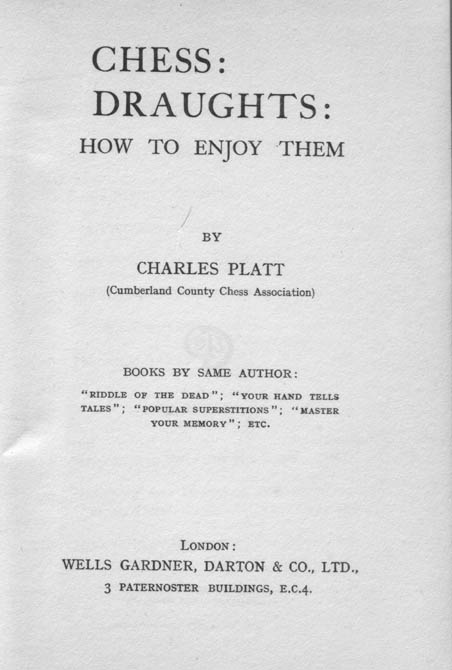
Platt also wrote on the game, with Chess: Draughts: How to enjoy them (London, 1933, and a slightly amended edition in 1941). Pages 53-57 had an example of his play, from a six-game blindfold display by Blackburne:
Joseph Henry Blackburne – Charles Platt
Occasion?
Center Counter-Game
1 e4 d5 2 d4 dxe4 3 Nc3 Nf6 (‘In this game White knew my fondness for the Counter Gambit, so he played this variation, instead of taking the pawn as usual. It is known as the “Blackman [sic] Gambit”, and is not often seen’ – Platt.) 4 Bg5 Bf5 5 Bc4 Nbd7 6 Nge2 Bg4 7 h3 Bxe2 8 Qxe2 Nb6 9 Bxf6 Nxc4 10 Qxc4 exf6 11 Nxe4 Be7 12 O-O-O O-O 13 g4 c6 14 Rhe1 Re8 15 Re2 Qc7 16 Rde1 Red8 17 c3 Bf8 18 Kb1 b5 19 Qb3 a5 20 Qc2 b4 (‘Black has the best of the game now, as White’s centre is weak and his rooks out of play for the moment. It ended in a draw, however, owing to White’s superior skill and experience in the endgame’ – Platt.)
It may seem paradoxical for doubled rooks on the e-file to be described as ‘out of play’.
On pages 65-70 he gave the following game:
Charles Platt – N.N.
Occasion?
Queen’s Fianchetto Defence
1 e4 b6 2 d4 Bb7 3 Nc3 e6 4 Bd3 Bb4 5 Bd2 a6 6 f4 Nf6 7 g4 d5 8
e5 Ne4 9 Bxe4 Qh4+ 10 Kf1 Bxc3 11 Bxc3 dxe4 12 Be1 Qe7 13 h4 (‘...
the late James Mason asked permission to include the game in his
fine work The Art of Chess because of this extraordinary
pawn play’ – Platt.) 13...c5 14 h5 f6 15 Bh4 Nd7 16 g5 fxe5 17 g6
Qd6 18 h6 hxg6 19 hxg7 Rg8 20 Bf6 Nxf6 21 Rh8 O-O-O 22 fxe5 Qxd4
23 Qxd4 Rxd4 24 exf6 Rdd8 25 Rxg8 Rxg8 26 f7 Resigns.
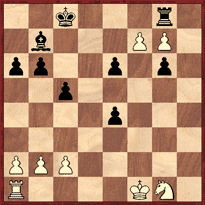
(‘A curious game, since White has 14 pawn moves in a game only lasting 26 moves’ – Platt.)
We have not traced this game in any of the various editions of The Art of Chess, but it was published by Mason on pages 114-115 of Social Chess. Both Platt and Mason criticized Black’s 23rd move.
Platt’s two other games in Social Chess (on page 98 and pages 111-112) are given below:
Charles Platt – N.N.
Occasion?
Bishop’s Opening
1 e4 e5 2 Bc4 Nf6 3 d3 c6 4 Nf3 d5 5 exd5 cxd5 6 Bb3 Nc6 7 Qe2 Bg4 8 O-O Bc5 9 Bg5 h6 10 h3 h5 (‘Black may win a piece by 10...Bxf3, etc., but he plays a nobler game’ – Mason.) 11 hxg4 hxg4 12 Nxe5 Nd4 13 Qe1
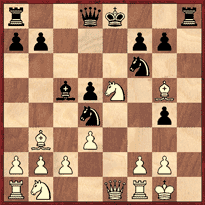
13...Ne4 14 Bxd8 Ng3 15 Ng6+ (Mason refers to ‘an exciting and amusing finish’, without mentioning that White could have prevented it with 15 Ba4+.) 15...Nge2+ 16 Qxe2+ Nxe2 mate.
Charles Platt – N.N.
Occasion?
Queen’s Pawn Opening
1 d4 d5 2 Bf4 e6 3 Nf3 Bd6 4 Bxd6 Qxd6 5 Nbd2 Nf6 6 e3 O-O 7 Bd3 c5 8 c3 c4 9 Bc2 Nc6 10 O-O Ne7 11 e4 Qd8 12 e5 Nd7 13 Ng5 h6 14 Bh7+ Kh8 15 Qh5 Ng8 16 Ndf3 hxg5 17 Bxg8+ Kxg8 18 Nxg5 Re8 19 Qxf7+ Kh8 20 Qh5+ Kg8 21 Qh7+ Kf8 22 Qh8+ Ke7 23 Qxg7 mate.
Platt annotated the above game on pages 58-61 of Chess: Draughts: How to enjoy them.
The book’s title page specified, after his name, ‘Cumberland
County Chess Association’. An article by A.R. Davies entitled
‘Chess in Cumberland’ was published on pages 145-156 of the April
1902 BCM and pages 213-215 of the May 1902 issue. It
included (on pages 154-155) a portrait of Platt and an account of
his connection with the Carlisle Club: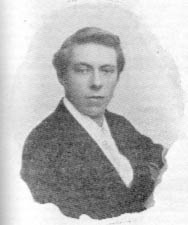
‘... in 1898 Mr Chas. Platt became president, and the club is indebted to him for a series of visits from celebrated chess masters. Mr Blackburne has been seen annually since 1898. Herr Mieses on two occasions, and Mr F.J. Lee quite recently. Mr D.Y. Mills also played the club simultaneously a few years ago. Mr Platt also became the donor of a trophy for the handicap tournament, which was re-instituted in 1896 ...’
Biographical details of Platt are scarce. On page 311 of The Year-Book of Chess, 1912 by E.A. Michell (London, 1912) Clara Millar gave his birth-date as 28 May 1865. We do not know at present when he died, or what became of his collection of chess sets. It may, though, be noted, that he wrote on subjects other than chess. The title page of his chess/draughts book listed the following as other books by him: ‘Riddle of the Dead, Your Hand Tells Tales, Popular Superstitions, Master Your Memory, etc.’
Bibliographies also state that an author named Charles Platt used the pseudonym ‘Professor Duncan’ for a book entitled How To Talk Correctly (various editions), while the chess anthologist E.V. Mitchell (see C.N. 3484) wrote The Horse and Buggy Age in New England, a book with two illustrations by a Charles Platt. In neither book, however, have we found any connection with Charles Platt of Cumberland.
On page 56 of Chess Characters (Geneva, 1984) G.H. Diggle wrote:
‘One seldom sees the name of James Mason (1849-1905) now; yet he was not only one of the inner ring of great masters but perhaps the finest chess writer of his time. His three great works were The Art of Chess, Principles of Chess and Social Chess. The introductory chapter of the last-named work has been ranked as one of the great set pieces of chess literature. Mason never wrote a dull sentence or used a redundant word.’
Social Chess ended (on pages 169-170) with ‘a few observations on the study and practice of chess’, and these included:
‘Many people imagine that chess cannot be profitably studied in books, that only “experience teaches”. But books are the body and soul of a vast mass of experience; and the study of book chess may be of the utmost value – to one who reads aright. As a matter of fact, and it is this which brings book study into disrepute, few players are more easily vanquished than those whose “book knowledge” is in advance of their practical experience. To be of real use, book knowledge should be made the player’s knowledge – a matter of general ideas, not of memory in detail, which applies only to the ABC of the game. The question always is “What should I do now? not what was I used to do, or what did so and so do in this or some similar position?” Chess cannot be taught, either by books or men, as one whistles tunes to a parrot.’
Per Skjoldager (Fredericia, Denmark) is writing a book on Nimzowitsch, jointly with Jørn Erik Nielsen, and here he offers an intriguing snippet:
‘C.N.s 1894, 1931 and 2879 discussed the exact date of Nimzowitsch’s birth, and even today there are some who believe that it was 7 February, rather than 7 November, 1886. Our book will present rock-solid proof that 7 November 1886 is the correct date.Even so, here is a copy of Nimzowitsch’s application form from the University of Zurich. In his own handwriting he gave his date of birth as 9 November 1886. A possible explanation of how Nimzowitsch made that mistake will also be offered in our book.’
Mr Skjoldager would like to hear from readers who possess rare material on Nimzowitsch, and we shall gladly pass on any messages received.
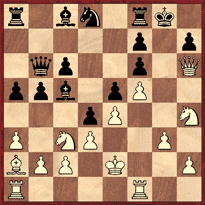
This position appears on page 166 of L’oeil tactique: l’entraînement à la combinaison by E. Neiman (Paris, 2003) and is merely labelled ‘Alexander – Marshall 1928’. The book notes that after 1 Rf4 exf4 2 gxf4 dxc3 Black would control g1, and the winning line is therefore given as 1 Na4 bxa4 2 Rf4 exf4 3 gxf4, after which 4 Rg1+ leads to mate.
An innocent reader might assume that the players were C.H.O’D. Alexander and F.J. Marshall. That, indeed, is the impression given by various later editions of Kombinationen by K. Richter (see position 297 and the index references). Already in the first edition (Berlin, 1936) Richter gave the position (see page 114), stating that the game went 1 Rf4 exf4 2 Na4 f3+ 3 Nxf3 Qa7 4 Ng5 fxg5 5 f6 Ne6 6 Bxe6 fxe6. As a caption Richter put ‘Meisterturnier Cambridge 1928’, an event unknown to us. C.H.O’D. Alexander went up to Cambridge University that year, but was he necessarily the Alexander in question? Other players active around that time were F.F.L. Alexander and L. Alexander, and there was also an E.T. Marshall; on page 162 of the April 1932 BCM all three of them were listed as members of the Lud-Eagle team.
At the moment no information can be offered about where the game was played or by whom. Nor has the complete score been found.
An Arthur Koestler novel set in Palestine, Thieves in the Night (New York, 1946), contains a number of references to chess, two of which are quoted below. Firstly, from page 92:
‘So the argument on Russia took its usual course, rather like a game of chess where at the opening stages both partners know the other’s answer in advance, and once it gets really going throw the chessmen at each other’s head. This time the throwing was started by Moshe our Treasurer. We had already got through the opening, to wit:
White (Queen’s pawn 4): Obvious untruth of the accusations against the Trotskyite opposition.
Black (Queen’s pawn 4): All opposition in a Workers’ State is a priori counter-revolutionary.
White (Queen’s Bishop pawn 4): Growing inequality of pay and privileges for the Bureaucracy.
Black (King’s Bishop pawn 3): Necessity to stimulate production by temporary expedients.
White (King’s Knight Bp. 3): Chauvinistic education, boosting of leadership, religious revival, etc.
Black (Queen’s Knight Bp. 3): Necessity of preparing backward masses for imperialist war and fascist aggression.
White (Dasha, pawn takes pawn): “They even encourage bourgeois decadence, like lipstick, rouge and powder.”
Black (Sarah, retakes pawn, blushes with rage): “The dialectics of proletarian sex-appeal as opposed to the prostitution of bourgeois matrimony ...”
It was at this stage that Moshe lost patience and upset the game.’
The second passage, from pages 134-135, is a curiosity, given that the book was published four years before Julio Kaplan was born:
‘... Mr Newton had looked as usual hopelessly pacific and absent-minded. He was walking with Kaplan, to whom he had just remarked:
“I’ve now played through all the games but three of the New York tournament, and I am more and more inclined to believe that the Indian opening is just a mode which won’t last.”
“No”, said Kaplan with his usual grimness of tone. “It is not just a mode, it is a new step in the evolution of the game. It’s manoeuvring under cover for position, which replaces the cavalry style of the old-fashioned King’s pawn openings, just as in soccer the strategy of the low pass replaced the old kick-and-run technique. In both cases it is planned, co-ordinated, collective action succeeding to individual bravado. The style of all games is influenced by changes in the pattern of social life.”’
From our collection: a baker’s dozen of sketches and caricatures of Richard Réti:
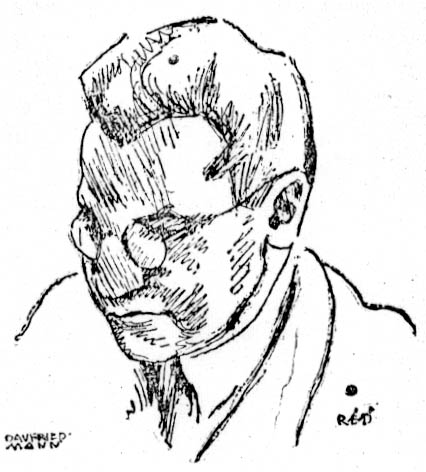 |
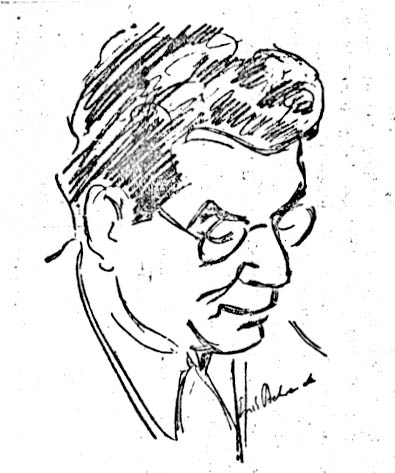 |
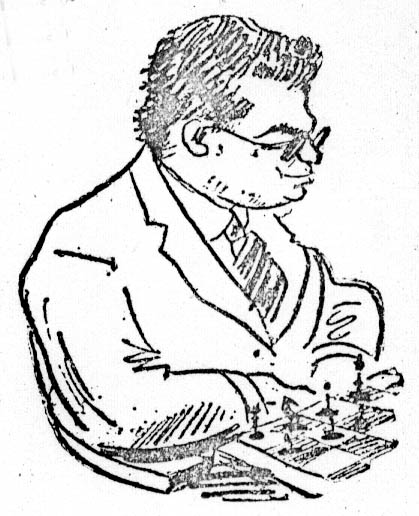 |
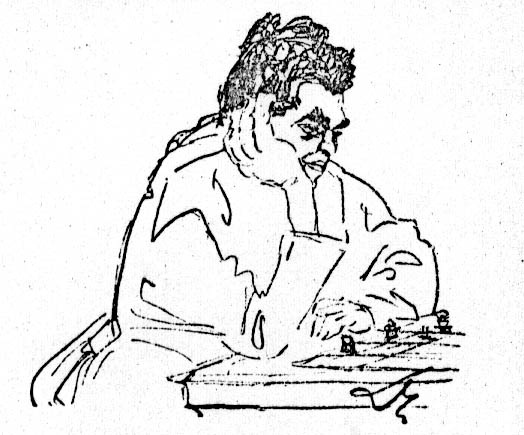 |
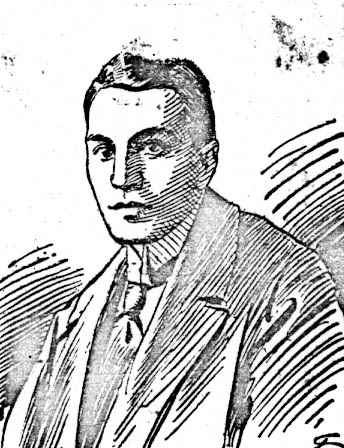 |
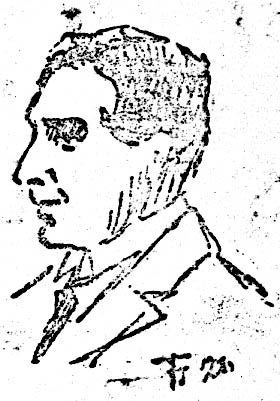 |
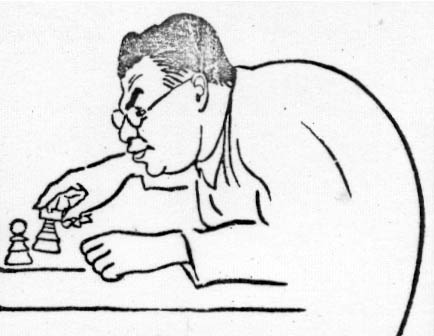 |
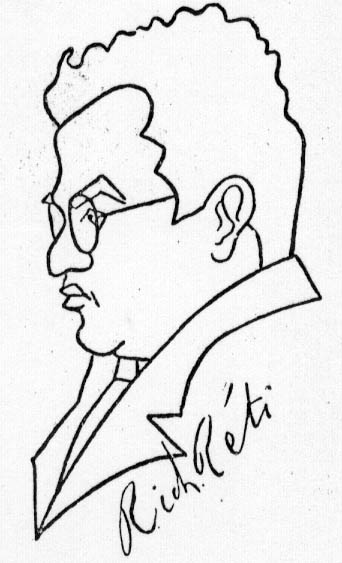 |
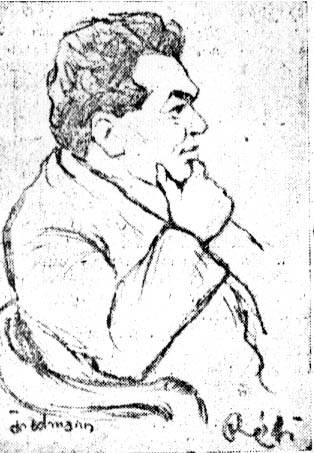 |
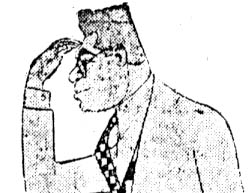 |
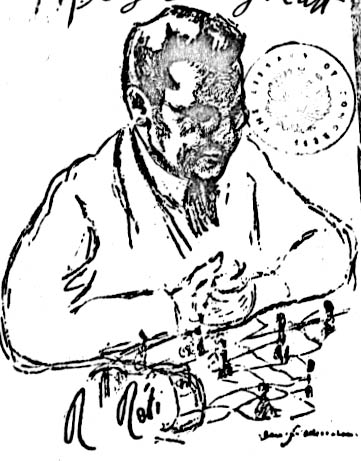 |
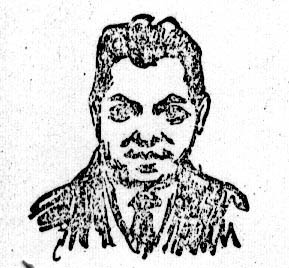 |
|
|
||
Stephen White of the Carlisle Library has kindly provided the
following details:
‘1891 census – Charles Platt, boarder at the Station House, Wetheral, Carlisle. He is aged 25, occupation woollen manufacturer, employer, born Hampstead, London.1901 census – Chas. Platt, aged 35, manager woollen mill, employee, born Hampstead, living at Thornleigh, Wetheral. Wife Eliza, aged 32, born Wigton near Carlisle. One servant living in.
The Cumberland Directories list Charles Platt at Thornleigh, Wetheral between 1894 and 1910, but not after this date. The 1905 Carlisle Directory lists him as President of the Carlisle Chess Club.’
From page 53 of Combinations The Heart of Chess by I. Chernev (New York, 1960):
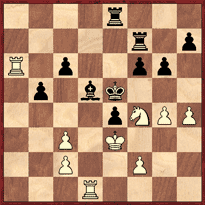
‘Hromádka – Opočenský
Kaschau, 19311 Rxd5+! cxd5 2 Nd3+! exd3 3 f4 mate!
And if perchance there are still some skeptics, here is the score of the entire game.’
Overleaf Chernev presented the 27-move game, as follows:
‘1 d4 f5 2 e4 fxe4 3 Nc3 Nf6 4 Bg5 Nc6 5 Bb5 d5 6 Bxf6 exf6 7 Qh5+ g6 8 Qxd5 Bb4 9 Qc4 Bxc3+ 10 bxc3 Bd7 11 Ne2 a6 12 Bxc6 Bxc6 13 Qe6+ Qe7 14 Qxe7+ Kxe7 15 Kd2 b5 16 h4 Kd6 17 Nf4 Raf8 18 Ke3 Rf7 19 a4 Rhf8 20 d5 Bxd5 21 axb5 axb5 22 Rhd1 c6 23 Ra6 Ke5 (On 23...Kc5 White ends it neatly by 24 Rxd5+! cxd5 25 Ne6+ Kc4 26 Rc6 mate.) 24 g4 (Apparently intending 25 Rxd5+ cxd5 26 Re6 mate.) 24...Re8 (Black parries the threat that he sees, but does not suspect that there may be a more subtle one. Now we have the position in the diagram above, when Hromádka wound up the game in problem-like style.) 25 Rxd5+! cxd5 26 Nd3+! exd3 27 f4 mate!’
It is odd, first of all, that Chernev did not specify that at move 24 White missed a mate in four through a combination identical to the actual finish (i.e. 24 Rxd5+ cxd5 25 g4, followed by 26 Nd3+ and 27 f4 mate) or that after the faulty 24 g4 Black could have played 24...Rd7.
But it is odder still that Chernev attributed the win to Hromádka, who was, in fact, Black. A similar mistake occurs in certain databases. On the other hand, the game was attributed correctly, though vaguely (‘a pretty win by Opočenský’), by Chernev and Reinfeld on page 122 of The Fireside Book of Chess (New York, 1949).
The score was published on pages 9-10 of the January 1932 Československý Šach, and Opočenský was named as White. The tournament crosstable, also given there, confirmed that he defeated Hromádka in that event, and the game was headed ‘Vánoční turnaj v Košicích 1931-1932’, i.e. ‘Christmas tournament in Košice 1931-1932’. There was no indication whether the game was played in 1931 or 1932. The mate missed by White at move 24 was pointed out by the Czech magazine.
Chernev’s ‘Kaschau’ is correct, being the town’s German name. In Hungarian it is Kassa, whereas in certain databases the faulty ‘Kauchau’ is used.
The present item (where use of Czech accents will enable readers to determine whether their computers are on the same technical wavelength) concludes with a reproduction from our copy of the book Nad šachovnicemi celého světa by K. Opočenský and V. Houška (Prague, 1960), inscribed by both authors:
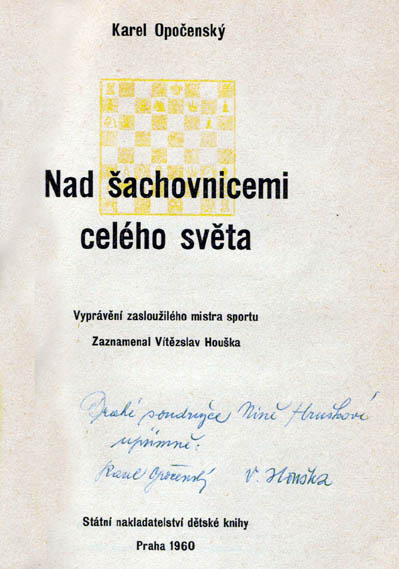
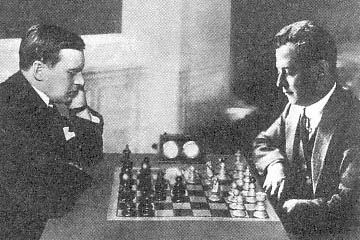
It may be recalled that in C.N. 3405 Luca D’Ambrosio (Bolzano,
Italy) suggested that, for reasons of lighting, background, etc.,
the above photograph, widely published, was a montage. We
concluded that there were further reasons for holding that view.
For instance, the position was from Nimzowitsch v Alekhine,
Semmering, 7 March 1926, and the board, pieces, clock and wall
corresponded to a picture (of other players) in the book of that
tournament (from which Capablanca was absent). Moreover, the
Capablanca part of the photograph was a reverse shot of the
portrait of him (i.e. the left half of our own composition below)
which had been published on page 14 of the “1. Extra-Ausgabe” of Kagans
Neueste Schachnachrichten in late 1925 or early 1926.
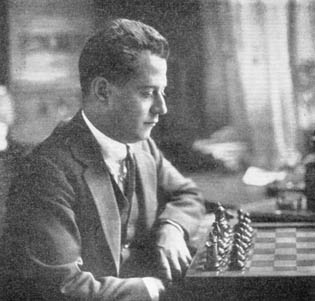
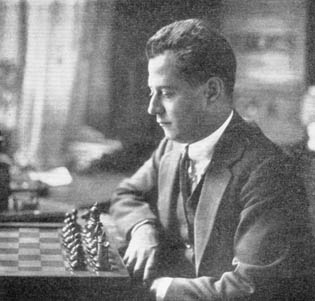
We have now found that the Alekhine-Capablanca picture appeared in the book on the 1927 world title match edited by Alekhine’s brother, Alexei, i.e. Match na pervenstvo mira Alekhin-Capablanca (Kharkov, 1927):
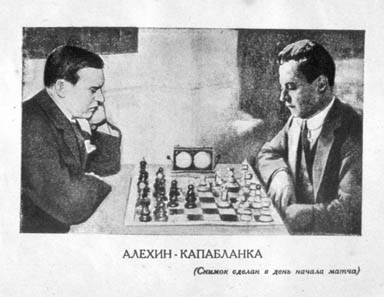
The caption asserts that the photograph was taken on the first day of the match.
We have also come across another Capablanca-Alekhine photograph which is a more obvious forgery:
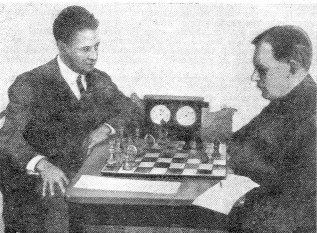
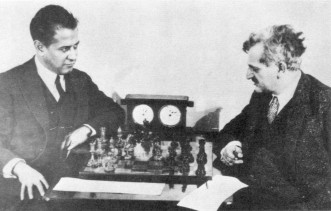
It was given on page 267 of the December 1927 issue of the Swedish magazine Schackvärlden. The Capablanca part of the photograph is recognizable as coming from a shot of him with Emanuel Lasker (in Moscow in 1925). See, for instance, the picture section of the Dover reprint of the New York, 1924 tournament book. For some reason the manipulator altered the position and depicted the board the wrong way round.
No reliable anthology of chess quotations exists in any language; to date there has been just the occasional brief throw-together of alleged bons mots, all of them sourceless. Nothing stamps a writer as untrustworthy more swiftly than an expectation that what he writes should be taken on trust.
There is something carefree and almost random about how the chess world attributes many writings and sayings to persons (Tartakower is a safe bet) and nations (‘Old Russian proverb’), and this often makes it impossible for the reader to determine what is genuine, erroneous or bogus. Our recommendation is to dispense with any publication or website which offers ‘chess quotes’ without indicating where and when the statements in question were purportedly made.
On page 279 of The Chess Companion (London, 1970) I. Chernev attributed the following to Tartakower:
‘The great master places a knight at K5; checkmate follows by itself.’
As was pointed out in C.N. 2194 (see pages 338-339 of A Chess Omnibus), Tartakower merely quoted an onlooker at a game won by O. Bernstein in Paris in 1933. On page 426 of L’Echiquier, 17 February 1934 Tartakower wrote:
‘“Ces grands-maîtres placent leur[s] Cavaliers à é5 et après les mats découlent d’eux-mêmes!” dit en voyant cette catastrophe un spectateur grincheux.’
A similar remark appeared on page 111 of Chernev’s The Bright Side of Chess (various editions, except the New York, 1961 version, which mysteriously omitted the Epigrams chapter):
‘Once get a knight firmly posted at king 6 and you may go to sleep. Your game will then play itself.’
This is attributed to Anderssen, whereas on page 174 of CHESS, 8 January 1955 Steinitz was said to have declared:
‘Let me establish an unassailable knight on K6 and I can go to sleep for the rest of the game.’
Can a reader provide a respectable nineteenth-century source relating to Anderssen, Steinitz or anybody else?
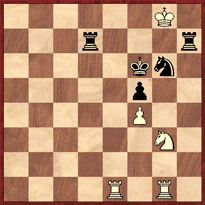
‘Do you believe in reincarnation of chess ideas? The diagram shows a position which occurred in a game played in 1945 between Jorgensen and Sorensen. This identical position is described by al-Adli in an Arabian manuscript dating back to the ninth century!
Jorgensen mated in three moves (thereby solving al-Adli’s problem) by 1 Nh5+ Rxh5 2 Rxg6+ Kxg6 3 Re6 mate!’
We now see that on pages 110-111 of an earlier book, Challenge To Chessplayers (Philadelphia, 1947), Reinfeld gave the same position with the same players named but, this time, with the caption ‘Storkovenhagen, 1945’. That appears to be a misspelling/miscopying of Storkøbenhavn (i.e. Greater Copenhagen) and suggests that Reinfeld took the position from a Danish source. But, if so, which? Incidentally, whereas his Fireside book referred to ‘this identical position’, in Challenge to Chessplayers Reinfeld wrote: ‘The position is almost [our italics] identical with the setting of a problem composed 1,000 years ago.’
The present item reverts to a number of issues from the past year or so which this column has, to date, been unsuccessful in resolving.
(A) It is, for example, disappointing still not to know the circumstances of the following Tal brilliancy discussed in C.N.s 3159 and 3170:
1 e4 c5 2 Nf3 d6 3 d4 cxd4 4 Nxd4 Nf6 5 Nc3 g6 6 Be3 Bg7 7 f3 Nc6 8 Qd2 Bd7 9 O-O-O Rc8 10 Kb1 Qa5 11 g4 h6 12 h4 a6 13 Be2 Ne5 14 g5 hxg5 15 hxg5 Rxh1
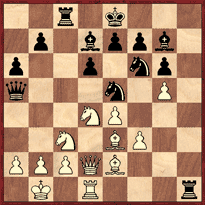
16 gxf6 Rxd1+ 17 Nxd1 Qxd2 18 fxg7 e6 19 g8(Q)+ Ke7 20 Qxc8 Resigns.
Sometimes it is stated that Black resigned at move 18. He is usually referred to as ‘N.N.’, although the surnames ‘Feuerstein’ and ‘Shmith’ [sic] have been seen. Various secondary sources state that the game was played in a simultaneous display in Germany (or, more specifically, Stuttgart) in 1958, but it was dated as late as 1970 by D.J. Morgan on page 232 of the June 1972 BCM. ‘Germany 1969’ was the heading on page 60 of Tal Since 1960 by W.H. Cozens (St Leonards on Sea, 1974), but was it, in fact, played before 1960?
Below is a Tal inscription from our collection:
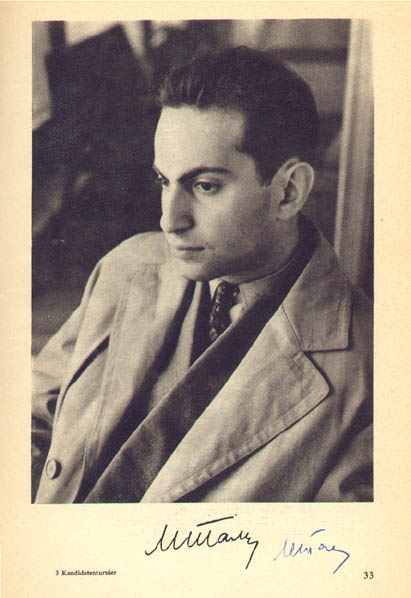
(B) An older fragment was discussed in C.N. 3301, which noted that the position below appeared (labelled ‘D. Harrwitz Date? Before 1858’) on page 430 of the November 1913 issue of La Stratégie:
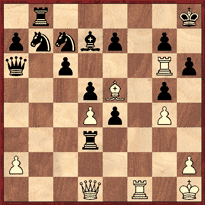
White, to move and win: 1 Rxg7 Rxd1 2 Rxe7+ Kg8 3 Rg7+ Kh8 4 Rxd7+ Kg8 5 Rg7+ Kh8 6 Rxc7+ Kg8 7 Rg7+ Kh8 8 Rxb7+ Kg8 9 Rxb8+ Kh7 10 Rh8+ Kg6 11 Rg8+ Kh7+ 12 Rg7+ Kh8 13 Rxg5+ Kh7 14 Rg7+ Kh8 15 Rxa7+ Kg8 16 Rxa6 Rxf1+ 17 Kg2.
What more is known about this specimen of the windmill/seesaw manoeuvre?
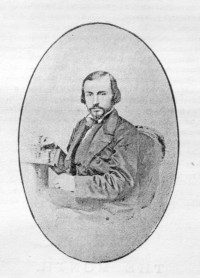
Daniel Harrwitz
(C) C.N. 3359 presented the following position:
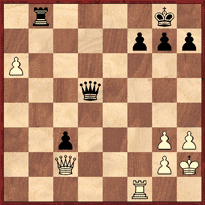
Play went 1...Rb2 2 Rd1 Qa8 3 Qe4 Rb8 4 Rb1 c2 5 Rxb8+ Qxb8 6 a7 Qc8 7 a8(Q) c1(Q) 8 Qe8+ and mate next move.
Our source was page 130 of Taktika Moderního Šachu by L. Pachman (Prague, 1962), which merely had the caption ‘Alapin – H.’. However, we pointed out that the same conclusion had been given on page 365 of the September 1904 issue of the Belgian magazine Revue d’échecs, with the following information: “Fin d’une partie jouée entre un fort joueur de Butler, M. H.A. Stauffer (Blancs) et un amateur de Boston (Noirs)”. The magazine’s source was the Brooklyn Daily Eagle.
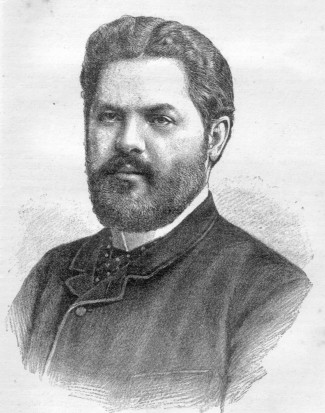 |
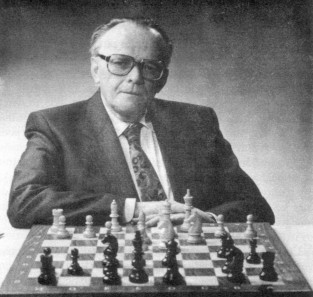 |
| Simon Alapin | Ludĕk Pachman |
(D) A discrepancy also exists concerning the next position, culled in C.N. 3288 from page 41 of Les échecs dans le monde by Victor Kahn and Georges Renaud (Monaco, 1952):
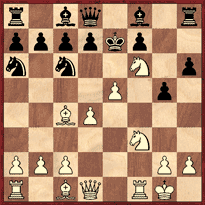
This was stated by Kahn and Renaud to be from a game between H.N. Pillsbury and E.F. Wendell in a simultaneous exhibition on 40 boards in Chicago, 1901, the finish being 12 Nxg5 hxg5 13 Qh5 Rxh5 14 Ng8+ Ke8 15 Bxf7 mate. However, we pointed out that the following score was on pages 319-320 of volume one of the second edition of Schachmeister Steinitz by L. Bachmann (Ansbach, 1925):
Wilhelm Steinitz – N.N.
London, 1873
(Remove White’s rook at a1.)
1 e4 e5 2 f4 Nc6 3 Nf3 Nf6 4 fxe5 Nxe4 5 d3 Nc5 6 d4 Na6 7 Bc4 Qe7 8 Nc3 h6 9 O-O g5 10 Nd5 Qd8 11 Nf6+ Ke7 12 Nxg5 hxg5 13 Qh5 Rxh5 14 Ng8+ Ke8 15 Bxf7 mate.
(E) C.N. 3029 quoted from a report in CHESS, 14 October 1936 (page 60) regarding the Philadelphia, 1936 tournament:
‘In his game with Santasiere, Fox made a three-move combination to win a pawn, and when he grasped it victoriously, lo and behold it turned out to be one of his own pawns. Certainly one of the most remarkable tricks fatigue has ever played on a participant in a gruelling tournament.’
We looked for the game-score, without success, in various magazines of the time and in Reinfeld’s tournament book (which had a selection of only 65 games).
Below is a group photograph from that book:
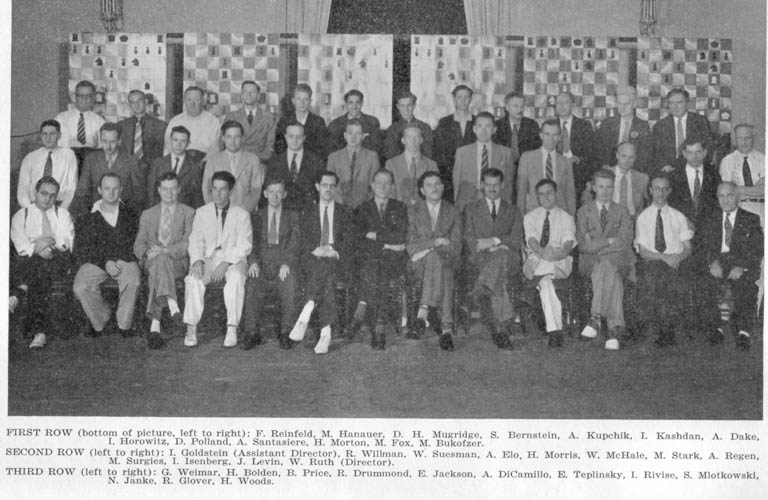
(F) Sometimes the full score of a game is known but the circumstances surrounding it are open to doubt. A case in point:
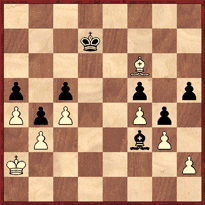
This was the final position in a game between Chigorin and Tarrasch in the Vienna tournament on 22 July 1898. C.N. 3379 quoted from page 68 of Chess Panorama by W. Lombardy and D. Daniels (Radnor, 1975):
‘Chigorin got fed up and offered a draw. Tarrasch refused. Chigorin knew Tarrasch well, and was half expecting that; he calmly removed his bishop from the board and said, in broken German, ‘Go ahead. Win.’ Tarrasch proceeded to reappraise the position in the light of this startling development, and then tamely agreed to a draw.’
Is this story corroborated by a contemporary source?
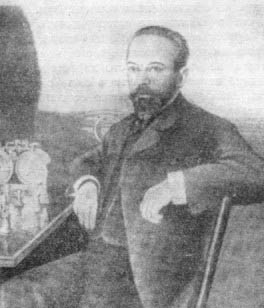
Mikhail Chigorin
(G) Other gaps include entire game-scores, in cases where it might be hoped that several would be available. C.N. 3109 quoted from an article by Mieses on pages 178-179 of the June 1949 BCM:
‘From the middle of February till the end of March I was engaged in a chess tour of Holland, Belgium and Luxemburg. That Holland and Belgium are countries where chess life is highly flourishing is a very well-known fact and, thus, I was not surprised that in Amsterdam, The Hague, Brussels, Antwerp, Louvain, Verviers, Charleroi they put up against me, in simultaneous exhibitions, rather strong teams of, on average, more than 20 players. But what I had not expected was that in Luxemburg I should have to give three simultaneous displays – each of them against about 25 opponents – on three consecutive days. Apart from the simultaneous displays I played, in Holland, repeatedly four serious simultaneous games against first-class amateurs. In all these exhibitions my achievements have been quite satisfactory.’
Below is a photograph of Mieses playing Black against Euwe in the Hastings, 1945-46 tournament:
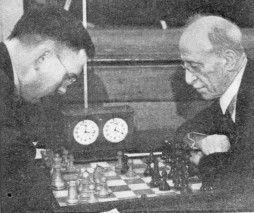
(H) Sometimes it has been impossible to establish the basic facts about purported events. C.N. 3230 discussed, inconclusively, reports of a one-thousand-game simultaneous display by an obscure player. For example, we quoted from page 337 of CHESS, 14 June 1938:
‘Several magazines and journals have reported that a certain Dr. Basker, of San Francisco, has played 1,000 opponents simultaneously, winning (after four days’ play) 343, drawing 519, losing 138. We believe the whole thing is a hoax.’
Was it?
(I) Then there are general questions relating to the history and terminology of chess. C.N. 3298 mentioned that reference books do not deal with the question of when ‘pin’ became part of chess terminology, and we wondered how much further back it might be traced than George Walker’s Chess Studies (London, 1844), which contains on page xii this remark: ‘Of course I consider that all players for whom I have made up these Chess Studies are acquainted with the ordinary chess terms, as bishop ‘pins’ knight, and similar conventional phrases.’
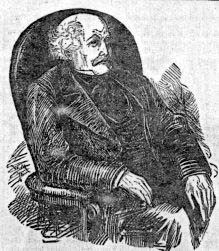
George Walker
(J) C.N. 3377 asked why, on page 65 of Ideas modernas en las aperturas de ajedrez (fifth edition, Buenos Aires, 1967), Tartakower referred to 1 e4 Nf6 2 Nc3 as the ‘Variante del Yatagán’. A subsequent item (C.N. 3392) noted that page 107 of the same book affirmed that the pawn formation e3-d4-c3 was known as ‘the Juncosa triangle’ in Spain and as ‘the Brake triangle’ in England. The explanation for ‘Brake’ has yet to be found.
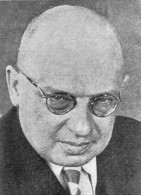
Savielly Tartakower
(K) Another wide field of uncertainty is who said what and when. C.N. 3330 quoted from page 62 of Modern Chess by Barnie F. Winkelman (Philadelphia, 1931), ‘But of Lasker it was said that he played P-K4 with a view to the endgame …’, but nothing has been found about the origins of the remark. Nor have we resolved a matter raised in C.N. 3348, i.e. what basis may exist for the following statement on page 3 of the January 1936 BCM:
‘Euwe has fulfilled the prophecy of Dr Emanuel Lasker, when he was still a boyish student, that he would one day win the world title.’
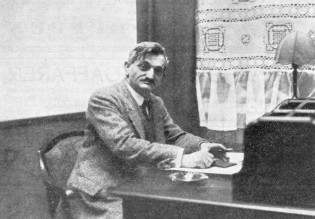
Emanuel Lasker
(L) Biographical gaps are not infrequent. C.N. 2776 requested, without success, information from contemporary press reports about the suicide of Rudolf Swiderski, at the age of 31, in Leipzig on 12 August 1909.
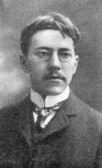
Rudolf Swiderski
(M) C.N. 3172 recalled that chess historians have so far been unable to determine beyond doubt the forename of S. Lipschütz. a former champion of the United States. As documented in Jeremy Gaige’s Chess Personalia, writers have put Simon, Solomon and Samuel. Gaige himself chose ‘S[ámuel?]’ and listed his date of death as 30 November 1905 (in Hamburg, at the age of 42).
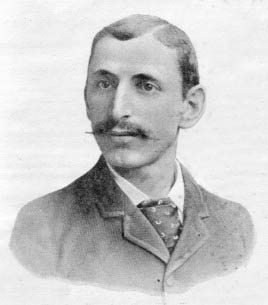
S. Lipschütz
(N) In C.N. 3217 it was R. Fine’s forename that was under discussion, the late Sidney Bernstein having written to us on 23 January 1987, ‘Dr Ruben (he spells it thus now) Fine’. So far, nothing has been traced to show that Fine changed from Reuben to Ruben in his later years.
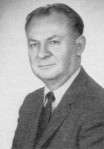
R. Fine
(O) With regard to Morphy’s origins, C.N. 3015 asked what was known about the connection between Morphy, Murphy and beer. It was recalled that H.R. Sadeghi (Lausanne, Switzerland) had sent us a beer-mat which bore a coat-of-arms identical to that of Morphy’s family:
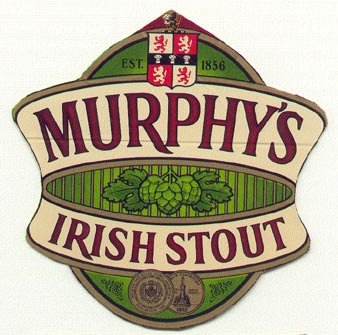
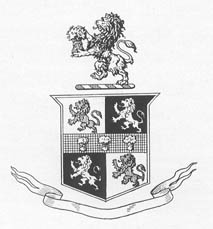
The black and white illustration comes from page 2 of the 1926 booklet Life of Paul Morphy in the Vieux Carré of New-Orleans and Abroad by Regina Morphy-Voitier, where the coat-of-arms was described as follows:
‘Morphy, alias Murphy. Quarterly argent and gules; four lions rampant interchanged, over all on a Fesse Sable three garbs or, Crest; a lion rampant holding a garb. (No Motto.)’
(P) Another little mystery has been a possible chess column by Rubinstein (C.N.s 3120 and 3124). We quoted from page 263 of the September 1918 BCM Alphonse Goetz’s remark that Rubinstein ‘used to conduct in his native town of Łódź a chess column in a little Yiddish paper, printed in Hebrew characters’. Earlier items (C.N.s 1705, 1843 and 1910) discussed the only volume for which authorship is credited to Rubinstein, La partida de ajedrez (Madrid, 1971), but the provenance of most of the annotations in that book also remains unclear.
Below is an inscription by Rubinstein in one of our copies of the monograph by Hans Kmoch Rubinstein Gewinnt! (Vienna, 1933):
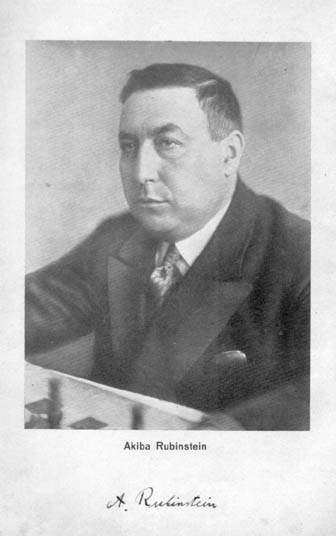
(Q) We have failed to find the photograph of Steinitz’s daughter (who died in 1888 at the age of 21) which, as noted in C.N. 3189, was referred to on page 79 of the Columbia Chess Chronicle, 17 March 1888 as follows:
‘El Sport, of Havana, devotes the entire first page to a portrait of the late Flora Steinitz.’
(R) Sometimes pictures exist but are, to say the least, dubious. C.N. 3239 asked whether there was any historical basis for the following portraits, allegedly of Ruy López and Greco, which appeared on pages 82 and 88 of Historia general del ajedrez by Julio Ganzo (third edition, Madrid, 1973):
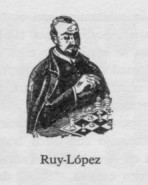
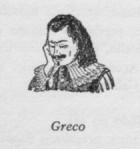
(S) Finally, as the era of the video recorder draws to an end, it has yet to be ascertained whether anybody has seen the cassette referred to in CHESS, July 1972, page 299 and quoted in C.N. 2787:
‘A chess programme in colour of 30 minutes’ duration has been recorded for television cassettes on a co-production basis between the Crown Television Group London and East End Productions in New York. It is based on Harry Golombek’s Penguin book The Game of Chess.’
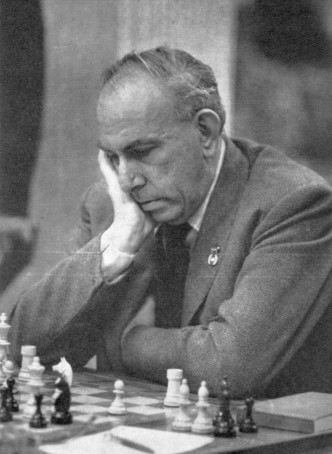
Harry Golombek
Readers with information on any of the above matters are invited to write in.
Chess Notes Archives:
| First column | << previous | Archives [3] | next >> | Current column |
Copyright 2004 Edward Winter. All rights reserved.